
 |
|
|
#1 (permalink) |
|
The Reforms
Location: Rarely, if ever, here or there, but always in transition
|
STARS & Space
The admittedly tiny & telescopic theme of which will come to pertain to those intriguing bits of spacedust up there.
Here is my fondest hope that you (dear audience) will come to enjoy what is presented (& come to participate, too!). #1:  -- (to note: sync'd up just right with the alignment of the New Moon.)
__________________
As human beings, our greatness lies not so much in being able to remake the world (that is the myth of the Atomic Age) as in being able to remake ourselves. —Mohandas K. Gandhi |
|
|
|
|
#2 (permalink) |
|
Riding the Ocean Spray
Location: S.E. PA in U Sofa
|
Hey Jet, what is that flashy astronomically inclined graphic above?
Since you started with an interesting "different" sort of pic, I'll also start with one I think is a different, interesting view of something familiar, our Moon.  This "illumination map" was constructed using over 1700 photographs of the same area of the moon's south pole taken by the Lunar Reconnaissance Orbiter Camera (LROC) over a six month period. Because the moon's rotational axis is tilted by only 1.54 degrees (compared to Earth's 23.5 degrees), some areas near its poles are left in permanent shadow, while nearby regions remain sunlit for most of the year. Each image taken by the LROC was projected onto a map of the area and converted to a binary image: if the ground was illuminated that pixel of the map was set to one, and if shadowed zero. Researchers then stacked all the binary images and calculated the percentage of the time each pixel was illuminated over the six month period. The resulting "illumination map" is shown above. Areas that were never illuminated appear black, areas that were always illuminated are white, and areas that were sometimes illuminated and sometimes in shadow appear as varying shades of grey. The Shackleton crater, 19 kilometres in diameter and 4 kilometres deep, can be seen at the centre of the image. The south pole is at approximately 9 o'clock on its rim. The LROC is making daily (which is about 28 Earth days) and yearly illumination maps for both poles in preparation for future lunar missions. ******************************************************** And since the above involved the Shackleton crater on the moon and Ernest Shackleton explored the South Pole on Earth, it reminded me of this unusual photo taken at the South Pole near the time of the summer solstice (a photo I've posted here a couple times in the past...but it's an oldie but goodie imo) of our home star, the Sun. It shows the time in Antarctica when the Sun never sets below the horizon:  |
|
|
|
|
#3 (permalink) | |
|
The Reforms
Location: Rarely, if ever, here or there, but always in transition
|
quick Re:
it's a fast-paced (and just as quickly grabbed) animated b-w outline image of the known galaxies able to seen through the Hubble Telescope, (c 2008) BadNick. Quote:
__________________
As human beings, our greatness lies not so much in being able to remake the world (that is the myth of the Atomic Age) as in being able to remake ourselves. —Mohandas K. Gandhi |
|
|
|
|
|
#4 (permalink) |
|
Riding the Ocean Spray
Location: S.E. PA in U Sofa
|
In case somebody looking in here hasn't seen this, check out Google Mars Google Mars
Also, if you care to download Google Earth, look at the toolbar at the top and the icon that looks like Saturn allows you to view Earth, Sky, Mars or Moon ...very interesting views and explorations possible. |
|
|
|
|
#5 (permalink) |
|
The Reforms
Location: Rarely, if ever, here or there, but always in transition
|
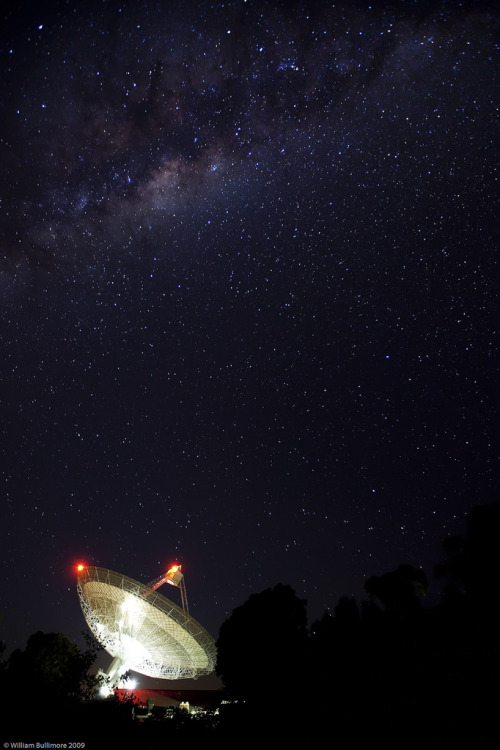 The Final Frontier by William Bullimore quick synopsis: Astronomers use the Parkes CSIRO Radio telescope to measure the radio energy produced naturally by objects in the universe such as stars, galaxies and clouds of dust and gas. In the spirit of international cooperation, this dish is occasionally used to help JPL/ NASA with collection of data from its spacecraft exploring the planets. Famous for its role in relaying Apollo 11 telemetry and television pictures from the Moon on 21st July, 1969 - the movie "The Dish" was loosely based on that involvement - it has more recently assisted with Voyager 2 at Uranus (January, 1986) and Neptune (August, 1989), Giotto at Comet Halley (March, 1986) and Galileo at Jupiter (most of 1997). {Photo taken in Parkes, New South Wales, Australia.}
__________________
As human beings, our greatness lies not so much in being able to remake the world (that is the myth of the Atomic Age) as in being able to remake ourselves. —Mohandas K. Gandhi |
|
|
|
|
#7 (permalink) | |
|
The Reforms
Location: Rarely, if ever, here or there, but always in transition
|
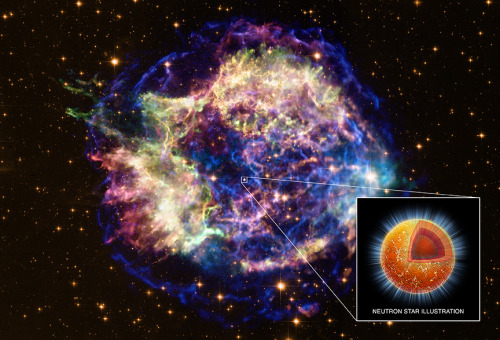 APOD: 2011 March 5 - Cooling Neutron Star Explanation: Quote:
__________________
As human beings, our greatness lies not so much in being able to remake the world (that is the myth of the Atomic Age) as in being able to remake ourselves. —Mohandas K. Gandhi |
|
|
|
|
|
#8 (permalink) |
|
Riding the Ocean Spray
Location: S.E. PA in U Sofa
|
Voyager images below from NSSDC PLANETARY IMAGE CATALOG
Image taken by Voyager 2 Io is seen in this image near the center of the frame in front of the southern hemisphere of Jupiter. The image was taken on 25 June 1979 from a distance of 12 million km. Io's yellowish color is due to sulfur compounds. Features as small as 200 km can be resolved in this image. Io is 3640 km in diameter, roughly the size of Earth's Moon, and north is at 11:30. (Voyager 2, P-21719)   Voyager 1 image of the Great Red Spot on Jupiter in enhanced color to bring out details. The Great Red Spot is about 12,000 km across its shortest dimension. It has been known since 1610, when Galileo first observed it with his telescope. It appears to be some sort of stable vortex in Jupiter's atmosphere. North is at 1:00. (Voyager 1, P-21229) From Eminem2Pac's Blog: Benvenuti  Celestron Celestar 8" + Imaging Source DBK21AU04.AS + Baader Ircut + Celestron barlow Ultima 2x + Extender, 75 avis processed to get this GIF, the first avi was recorded at 0.24 of 15/9/2010 while the last avi was recorded at 3.05 of 15/9/2010, the total time is 2 hour and 40 minutes, here Jupiter + Great Red Spot + Europa Moon From Views of the Solar System Photo Gallery  Jupiter's Great Red Spot | Hayden Planetarium  This brief animation shows the motion of the clouds in the Jovian atmosphere. Most notable is the dark, oval-shaped Great Red Spot. The animation was compiled from blue filter images taken using the narrow-angle camera on NASA's Cassini spacecraft during seven rotations of Jupiter between October 1 and October 5, 2000. The images reveal an area on Jupiter centered on the equator that extends about 50° north and south and covers 100° east-west (about a quarter of Jupiter's circumference). From From NASA - Map of Jupiter's South This map of Jupiter is the most detailed global color map of the planet ever produced. The round map is a polar stereographic projection that shows the south pole in the center of the map and the equator at the edge. It was constructed from images taken by Cassini on Dec. 11 and 12, 2000, as the spacecraft neared Jupiter during a flyby on its way to Saturn. The map shows a variety of colorful cloud features, including parallel reddish-brown and white bands, the Great Red Spot, multi-lobed chaotic regions, white ovals and many small vortices. Many clouds appear in streaks and waves due to continual stretching and folding by Jupiter's winds and turbulence. The bluish-gray features along the north edge of the central bright band are equatorial "hot spots," meteorological systems such as the one entered by NASA's Galileo probe. Small bright spots within the orange band north of the equator are lightning-bearing thunderstorms. The polar region shown here is less clearly visible because Cassini viewed it at an angle and through thicker atmospheric haze.  Last edited by BadNick; 03-06-2011 at 05:27 PM.. |
|
|
|
|
#9 (permalink) |
|
The Reforms
Location: Rarely, if ever, here or there, but always in transition
|
light-hearted revival
 “Astronomatryoshkas”, crafted by Nate Bellegrade. author's comments: My girlfriend is majoring in Astronomy, so for her birthday I made some astronomer matryoshkas. She is really awesome so I tried to make a gift as awesome as she is. I had planned them out for months and it was great to finally be able to give them to her and see the look on her face as she opened each one. These were done with acrylic on wood (I am really rusty at painting and acrylics are maybe my least favorite medium :/), and I kind of cheated and used a brush pen for the black lines, since I couldn't really pull off the detail in paint. The downside is that the ink from the pens comes off the paint when you handle them so I have to put a varnish on them. Hopefully, if you know anything about famous astronomers, you can guess who they are (without cheating!). [superpunch.]
__________________
As human beings, our greatness lies not so much in being able to remake the world (that is the myth of the Atomic Age) as in being able to remake ourselves. —Mohandas K. Gandhi |
|
|
|
|
#11 (permalink) |
|
Riding the Ocean Spray
Location: S.E. PA in U Sofa
|
 The above image was taken by the Cassini spacecraft in mid January in infrared and polarized light. Titan looms just over the thin rings, while dark ring shadows on Saturn show the Sun to be above the ring plane. Close inspection of the image will show the smaller moon Enceladus on the far right. Cassini, humanity’s first mission to orbit Saturn, currently has operations planned until 2017. |
|
|
|
|
#12 (permalink) |
|
The Reforms
Location: Rarely, if ever, here or there, but always in transition
|
NASA - Multimedia: STS-133 Booster Camera Views [video ; out-of-this-world]
quick synopsis: Video recorded by cameras mounted on Discovery's twin solid rocket boosters provide unique views of the February 24 launch. + bonus  Last Discovery launch --Photo by: Michael Erard {Taken in Cape Canaveral, FL, on Feb. 24, 2011.}
__________________
As human beings, our greatness lies not so much in being able to remake the world (that is the myth of the Atomic Age) as in being able to remake ourselves. —Mohandas K. Gandhi Last edited by Jetée; 03-09-2011 at 08:01 AM.. |
|
|
|
|
#13 (permalink) |
|
The Reforms
Location: Rarely, if ever, here or there, but always in transition
|
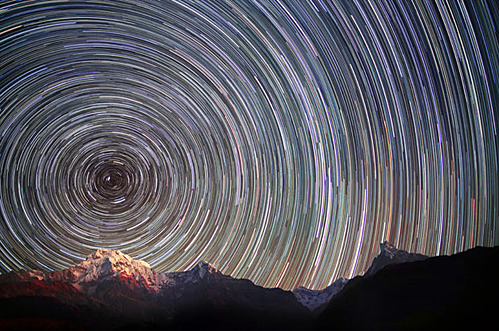 Photographer Anton Jankovoy spent months camping at the foot of Mount Everest in a bid to capture the perfect picture of star trails over the Himalayas. Anton, from Zhytomyr in Ukraine, used a Canon EOS 5D Mark II with a 24mm lens to capture this picture, leaving the shutter open for several hours. author's comments: (A. Jankovoy) I adore photography, especially landscapes because I can just sit there and observe the nature around me. It's so peaceful. But because star trail images need very long shutter speeds they take a lot of patience. I've learnt how to endure the freezing cold by meditating. It's surprising but it really helps. Although I started taking photographs when I was nine years old I really learnt to cultivate my skills when taking photographs in the mountains. All my childhood I dreamt about mountains and hoped to visit Nepal one day. Then four years ago, after saving for a year-and-a-half, I made my first trip to the Himalayas. I visited Mount Everest and it was like a revelation to me, a different world, a different way of life, almost a different universe to what I had known in the Ukraine. It had a profound effect on me and seriously changed my life. I fell in love with Nepal, the people and the amazing scenery. When I came home I realised I couldn't go back to my old way of life and so for the last three years I've lived in Nepal for six months of the year. It has taken a lot of dedication and patience but the result has been worth it. + BONUS  Peaks including the Annapurna South and the Hiunchuli can be seen in this spectacular image, which took hours to capture and expose [Telegraph. / DailyMail.]
__________________
As human beings, our greatness lies not so much in being able to remake the world (that is the myth of the Atomic Age) as in being able to remake ourselves. —Mohandas K. Gandhi |
|
|
|
|
#14 (permalink) |
|
Tilted
Location: Houston,Tx
|
Storm on Saturn
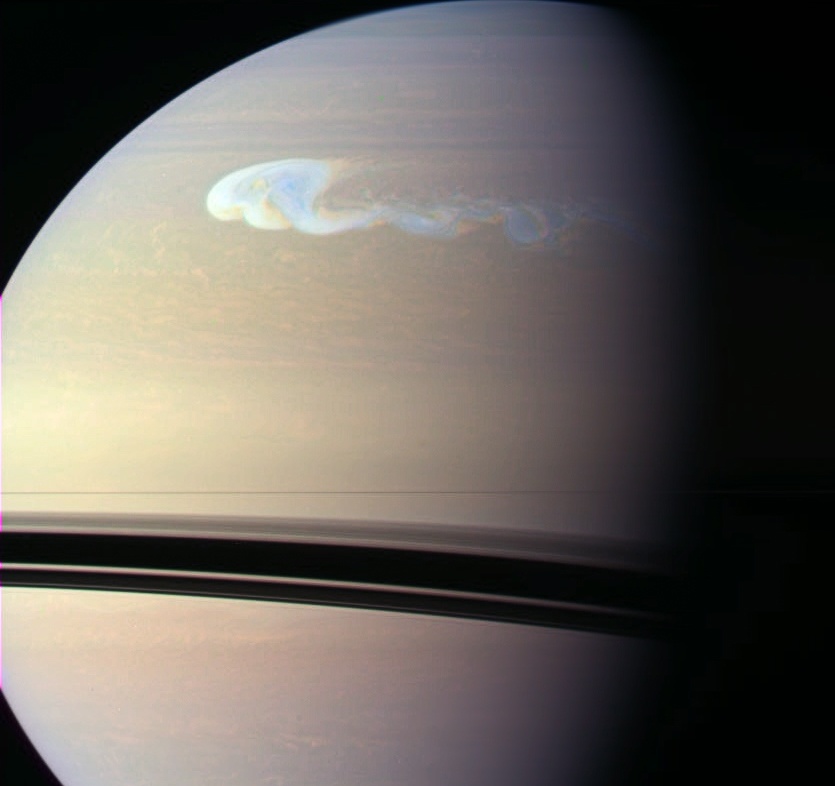 Late last year, a new, remarkably bright storm erupted in Saturn's northern hemisphere. Amateur astronomers first spotted it in early December, with the ringed gas giant rising in planet Earth's predawn sky. Orbiting Saturn, the Cassini spacecraft was able to record this close-up of the complex disturbance from a distance of 1.8 million kilometers on December 24th. Over time, the storm has evolved, spreading substantially in longitude, and now stretches far around the planet. Saturn's thin rings are also seen slicing across this space-based view, casting broad shadows on the planet's southern hemisphere |
|
|
|
|
#15 (permalink) |
|
The Reforms
Location: Rarely, if ever, here or there, but always in transition
|
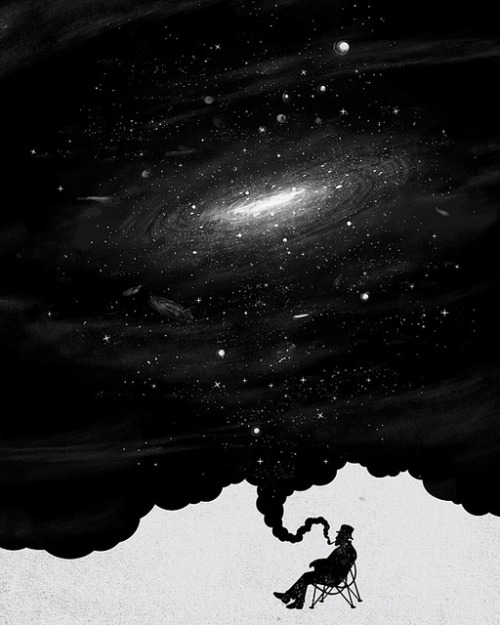 In Nostalgic Mood. (The retired astronaut.) design by Yau Hoong Tang.
__________________
As human beings, our greatness lies not so much in being able to remake the world (that is the myth of the Atomic Age) as in being able to remake ourselves. —Mohandas K. Gandhi |
|
|
|
|
#16 (permalink) |
|
The Reforms
Location: Rarely, if ever, here or there, but always in transition
|
Space shuttle Discovery and the six-person STS-133 crew lifted off from
NASA's Kennedy Space Center in Florida on Feb. 24, 2011, starting a mission to the International Space Station. At 11:57 a.m. EST on Mar. 9, 2011, space shuttle Discovery landed for the final time at NASA's Kennedy Space Center after 202 orbits around Earth and a journey of 5,304,140 miles on STS-133. STS-133 was the 39th and final flight for Discovery, which spent 365 days in space, orbited Earth 5,830 times and traveled 148,221,675 miles.
__________________
As human beings, our greatness lies not so much in being able to remake the world (that is the myth of the Atomic Age) as in being able to remake ourselves. —Mohandas K. Gandhi |
|
|
|
|
#17 (permalink) |
|
Riding the Ocean Spray
Location: S.E. PA in U Sofa
|
Please keep me in the dark about such matters.
Jasper becomes world's largest 'astronomy park' - CTV News  |
|
|
|
|
#19 (permalink) |
|
Riding the Ocean Spray
Location: S.E. PA in U Sofa
|
 Illustration of a supermassive black hole at the center of a galaxy. Using new data from ESA’s XMM-Newton spaceborne observatory, astronomers have probed closer than ever to a supermassive black hole lying deep at the core of a distant active galaxy known as 1H0707-495. XMM-Newton detected two bright features of iron emission in the reflected X rays that astronomers had never seen together in an active galaxy. These bright features are known as the iron L and K lines, and they can be so bright only if there is a high abundance of iron. Seeing both in this galaxy suggests that the core is much richer in iron than the rest of the galaxy. The direct X-ray emission varies in brightness with time. During the observation, the iron L line was bright enough for XXM-Newton to follow its variations. A painstaking statistical analysis of the data revealed a time lag of 30 seconds between changes in the X-ray light observed directly and those seen in its reflection from the disk. This delay in the echo enabled scientists to measure the size of the reflecting region, which lead to an estimate of black hole's mass to be about 3 to 5 million solar masses. The observations of the iron lines also reveal that the black hole is spinning very rapidly and eating matter so quickly that it verges on the theoretical limit of its eating ability, swallowing the equivalent of two Earths per hour. The team is continuing to track the galaxy using its new technique. Far from being a steady process, a feeding black hole is a messy eater. "Accretion is a very messy process because of the magnetic fields that are involved," Fabian said. The team's new technique will enable the astronomers to map out the process in all its complexity, taking them to previously unseen regions at the very edges of this and other supermassive black holes. |
|
|
|
|
#21 (permalink) | |
|
The Reforms
Location: Rarely, if ever, here or there, but always in transition
|
 First Image Ever Obtained from Mercury Orbit | NASA {Captured on Tuesday morning (March 29, 2011) at 5:20am EDT ; Photo by: NASA's MESSENGER Spacecraft} Why you may be interested: Quote:
__________________
As human beings, our greatness lies not so much in being able to remake the world (that is the myth of the Atomic Age) as in being able to remake ourselves. —Mohandas K. Gandhi |
|
|
|
|
|
#24 (permalink) |
|
The Reforms
Location: Rarely, if ever, here or there, but always in transition
|
Over 5,000 space-flight shots of Saturn coalesce ideally, by the Cassini Imaging Team
This video is made entirely by images captured from the Cassini spacecraft and the best part is, this awesome clip is actually a teaser for a larger IMAX called "Outside In" that is currently in production. -- Music: Adagio for Strings (NY Philharmonic) FOR MORE INFO, CLICK BELOW [APOD. / vimeo.]
__________________
As human beings, our greatness lies not so much in being able to remake the world (that is the myth of the Atomic Age) as in being able to remake ourselves. —Mohandas K. Gandhi Last edited by Jetée; 04-04-2011 at 04:55 PM.. |
|
|
|
|
#25 (permalink) | |
|
The Reforms
Location: Rarely, if ever, here or there, but always in transition
|
Speaking of which:
The Aurora(s) Over Norway by Terje Sørgjerd. Music featured: Gladiator Soundtrack: 'Now we are Free' Quote:
[APOD.] -- courtesy of Biorequiem.
__________________
As human beings, our greatness lies not so much in being able to remake the world (that is the myth of the Atomic Age) as in being able to remake ourselves. —Mohandas K. Gandhi |
|
|
|
|
|
#26 (permalink) |
|
The Reforms
Location: Rarely, if ever, here or there, but always in transition
|
Gallery: Discovery's Last Voyage
Space shuttle Discovery's next mission will be to awe and inspire those who visit it at the Smithsonian Institution. NASA's workhorse shuttle was retired after completing its trip last month to the International Space Station -- that’s 39 missions covering 5,750 orbits, 150 million miles, and almost a year in space since it first lifted off in 1984. It's name was inspired by the exploring ships of the past, including one that plied the Hudson Bay in the early 1600s seeking a northwest passage from the Atlantic to the Pacific oceans. Discovery carried some of NASA's most-distinguished astronauts, including Eileen Collins, the first female commander, Sergei Krikalev, the first Russian to fly on a shuttle, and Senator John Glenn, who returned to space at 76. In its last mission, Discovery dropped Robonaut 2, the first dexterous humanoid robot in space, at the space station. -- Lloyd Young  -- heads up, courtesy of Claes Källarsson.
__________________
As human beings, our greatness lies not so much in being able to remake the world (that is the myth of the Atomic Age) as in being able to remake ourselves. —Mohandas K. Gandhi |
|
|
|
|
#28 (permalink) | |
|
The Reforms
Location: Rarely, if ever, here or there, but always in transition
|
 "The Milky Way Over Tenerife" by Juan Carlos Casado (Spain) Explanation (abridged): Quote:
[APOD.]
__________________
As human beings, our greatness lies not so much in being able to remake the world (that is the myth of the Atomic Age) as in being able to remake ourselves. —Mohandas K. Gandhi |
|
|
|
|
|
#29 (permalink) |
|
The Reforms
Location: Rarely, if ever, here or there, but always in transition
|
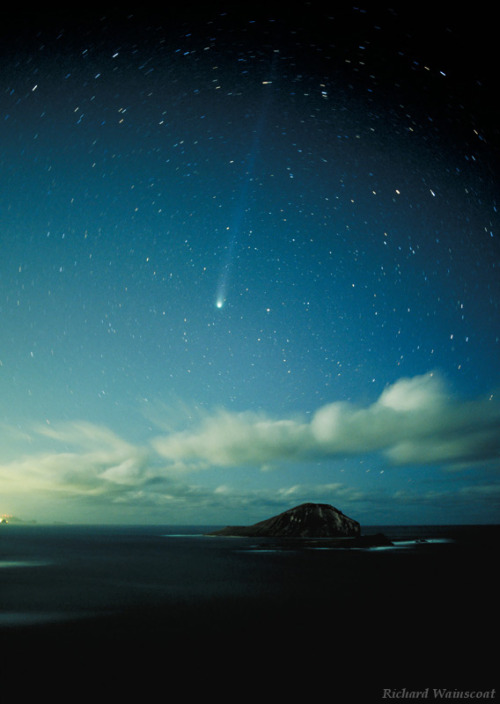 “Hyakutake over Rabbit Island” by Richard Wainscoat (as seen in Oahu, Hawaii, USA) author's comments: Comet Hyakutake over Rabbit Island (Manana Island), Oahu, Hawaii. On the night this photo was taken the comet passed very close to Polaris, so a sharp image of the comet could be obtained without use of an equatorial mount to compensate for the Earth's rotation. As you move further away from the north celestial pole the Earth's rotation leaves clear star trails in this long exposure. This photograph was taken using film in 1996. With a modern digital camera (which are more sensitive than film), a short enough exposure could be used to freeze both the land and the sky, without any trailing from the Earth's rotation.
__________________
As human beings, our greatness lies not so much in being able to remake the world (that is the myth of the Atomic Age) as in being able to remake ourselves. —Mohandas K. Gandhi |
|
|
|
|
#30 (permalink) | |
|
The Reforms
Location: Rarely, if ever, here or there, but always in transition
|
 Rain on Titan - artwork by David A. Hardy. Explanation (in full): Quote:
I originally painted this, in acrylics, early in 2010, having seen reports of methane rain on the Cassini website. I knew that radio bursts had been detected too, so wondered whether there actually could be lightning and asked Carolyn Porco, who said it hadn't been seen but that didn't mean there couldn't be any. Then last week I saw the report of rainstorms on Titan [March 17, 2011 news release], so sent this image! I had to use artist's license to show Saturn through a brief gap in the clouds. -- David A. Hardy is European Vice President of the International Association of Astronomical Artists (IAAA). [APOD.]
__________________
As human beings, our greatness lies not so much in being able to remake the world (that is the myth of the Atomic Age) as in being able to remake ourselves. —Mohandas K. Gandhi |
|
|
|
|
|
#32 (permalink) |
|
The Reforms
Location: Rarely, if ever, here or there, but always in transition
|
I've been meaning to add a bit of musical inclination inside the observatory from...
... the very beginning. (* -)
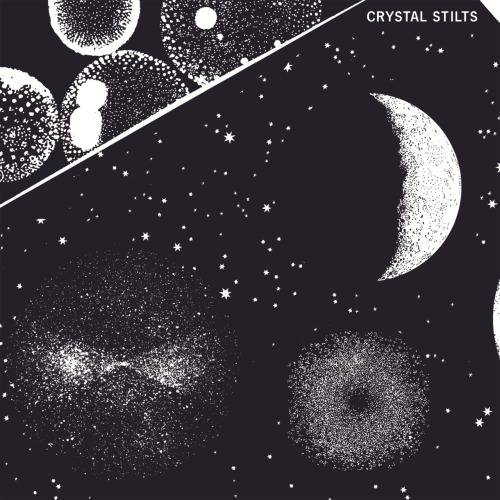 In Love With Oblivion, (2011) by Crystal Stilts. #currently live-streaming the new album. -- (to note: I especially like the tune, Flying Into the Sun, which I am re-listening to now.)
__________________
As human beings, our greatness lies not so much in being able to remake the world (that is the myth of the Atomic Age) as in being able to remake ourselves. —Mohandas K. Gandhi |
|
|
|
|
#33 (permalink) |
|
The Reforms
Location: Rarely, if ever, here or there, but always in transition
|
I'm still in that vibe of relating music to the heavens
 Cat Power - Rockets (cont.) ... and then, relating imagery to the lyrics ...  The Red Pyramid by Maurice Graham - - - Angel wings tonight Appear normal in daylight They shine and dazzle With glittering shimmer Reflections of the sun Keep babies protecte From the bad Guiding them to good Hovering above them as they sleep Watching as they peacefully dream -- Unique-Mystique- - -  Bryan Collins Good Thing Zach Doesn't Dream, 2007 acrylic on canvas 5″×7″
__________________
As human beings, our greatness lies not so much in being able to remake the world (that is the myth of the Atomic Age) as in being able to remake ourselves. —Mohandas K. Gandhi |
|
|
|
|
#34 (permalink) |
|
The Reforms
Location: Rarely, if ever, here or there, but always in transition
|
The fitting end to this eerie endeavor... I have more, but I'll leave you in suspense
__________________
As human beings, our greatness lies not so much in being able to remake the world (that is the myth of the Atomic Age) as in being able to remake ourselves. —Mohandas K. Gandhi |
|
|
|
|
#35 (permalink) | |
|
The Reforms
Location: Rarely, if ever, here or there, but always in transition
|
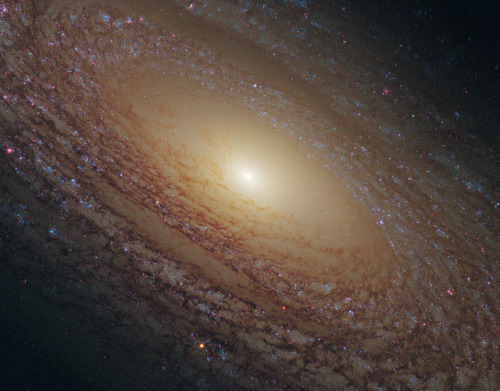 NASA’s Hubble Sees A Majestic Disk of Stars | captured by NASA Goddard Space Flight Center NASA image release Feb. 17, 2011 Explanation: Quote:
__________________
As human beings, our greatness lies not so much in being able to remake the world (that is the myth of the Atomic Age) as in being able to remake ourselves. —Mohandas K. Gandhi |
|
|
|
|
|
#36 (permalink) | |
|
The Reforms
Location: Rarely, if ever, here or there, but always in transition
|
50th anniversary of the first manned spaceflight orbit
 Today's (April, 12, 2011) Google Doodle... celebrating Yuri Gagarin's successfully completed orbit of the Earth, 50 years ago on this date, thus marking him as the first man in space. - - -  Yuri Gagarin: First Human in Space - - - Yuri's Night is an international celebration held on April 12 every year to commemorate space exploration milestones. To commerate the 50th Anniversary this year, the Expedition 27 crew aboard the International Space Station sent a special video message to the world below to wish them a Happy Yuri's Night.  A patron dines under a painting of Yuri Gagarin in Kazakhstan on August 9, 2006. Gagarin's fame outlived the Soviet Union itself, which ceased to be in 1991. READ MORE. -- Photo: Uriel Sinai/Getty Images - - - Quote:
- - - - - additional: [NationalGeographic. / russianarchives. / NYTimes. / TIME. / wiki.]
__________________
As human beings, our greatness lies not so much in being able to remake the world (that is the myth of the Atomic Age) as in being able to remake ourselves. —Mohandas K. Gandhi |
|
|
|
|
|
#37 (permalink) |
|
The Reforms
Location: Rarely, if ever, here or there, but always in transition
|
“The Frontier is Everywhere” by damewse
author's comments: In all of their brilliance, NASA seems to have forgotten to share their hopes and dreams in a way the public can relate to, leaving one of humanities grandest projects with terrible PR and massive funding cuts. I have a lot of ideas for a NASA marketing campaign, but I doubt they’d pay me even minimum wage to work for them. + bonus: Part 2
__________________
As human beings, our greatness lies not so much in being able to remake the world (that is the myth of the Atomic Age) as in being able to remake ourselves. —Mohandas K. Gandhi |
|
|
|
|
#38 (permalink) |
|
Riding the Ocean Spray
Location: S.E. PA in U Sofa
|
Milky Way over Chile's Very Large Telescope array:
 ---------- Post added at 11:32 PM ---------- Previous post was at 11:21 PM ---------- Interesting vid showing E-ELT in Chile and more night sky: ---------- Post added at 11:33 PM ---------- Previous post was at 11:32 PM ----------  |
|
|
|
|
#39 (permalink) | ||
|
The Reforms
Location: Rarely, if ever, here or there, but always in transition
|
follow-up, about 3 weeks later...
excerpt: Quote:
 A full moon sets over Hungary, Photograph by Tamas Ladanyi (TWAN) source: "Supermoon" Tonight: Biggest Full Moon in 18 Years - - - - - excerpt: Quote:
__________________
As human beings, our greatness lies not so much in being able to remake the world (that is the myth of the Atomic Age) as in being able to remake ourselves. —Mohandas K. Gandhi |
||
|
|
|
|
#40 (permalink) |
|
The Reforms
Location: Rarely, if ever, here or there, but always in transition
|
__________________
As human beings, our greatness lies not so much in being able to remake the world (that is the myth of the Atomic Age) as in being able to remake ourselves. —Mohandas K. Gandhi |
|
|
|
|